


This Week in Panels: Week 100 SUPER SPECIAL EXTRAVAGANZA! (Part 1)
August 22nd, 2011 Posted by GavokGod, has it been 100 installments of this garbage already? Well, I said we’d be doing something special and I wasn’t lying. The regular update is merely the appetizer.
So for those of you seeing this for the first time because of the allure of triple digits, here’s the skinny: every week, me and my crew (usually 4L boss man David Brothers and readers Was Taters and Space Jawa) supply panels for all the comics we’ve read from the previous Wednesday. Each panel is meant to be a breakdown of what the comic is about. The essence. The chance to sell it and show off its tone. Give you an idea of what its contents are all about. Yes, some people actually enjoy this. Go figure.
Now let’s get moving.

Avengers #16
Brian Michael Bendis and John Romita Jr.
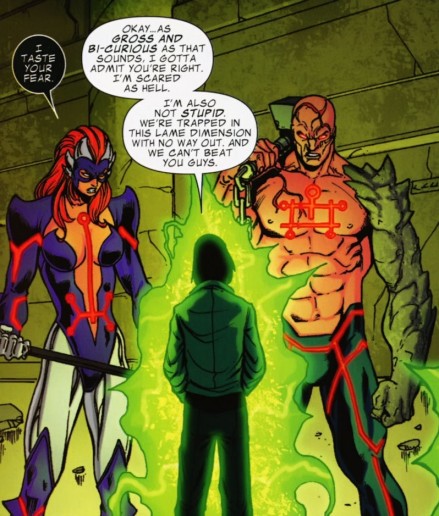
Avengers Academy #18
Christos Gage and Andrea DiVito

This Week in Panels: Week 75
February 27th, 2011 Posted by GavokIt’s the ThWiP 75th Week Double-Sized Spectacular! …Okay, it isn’t double-sized. It differs from week to week, so you can’t even define what single-sized is anyway. But I do have Was Taters and Space Jawa helping me out, so that’s neat.
Plus Deadpool Team-Up has the most Gavokian panel in the history of panels.
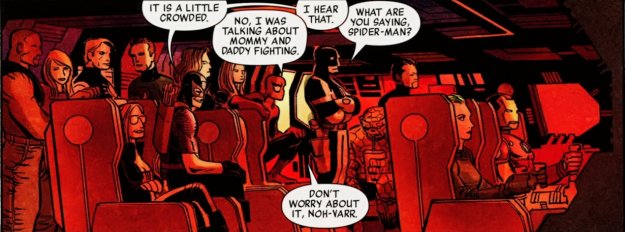
Avengers #10
Brian Michael Bendis and John Romita Jr.

Captain America #615
Ed Brubaker, Butch Guice, Sean McKeever and Filipe Andrade

This Week in Panels: Week 73
February 13th, 2011 Posted by Gavok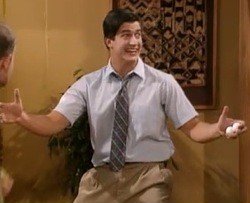
“HEY, EVERYBODY!”
Louie!
“WHO’S GOT SOMETHIN’ FOR ME?!”
I do!
“WHAT IS IT?!”
A bunch of panels from comics that that me, David Brothers, Was Taters, Space Jawa and David Uzumeri read this week!
“…eh, what the hell. I WANNA DIP MY BALLS IN IT!”
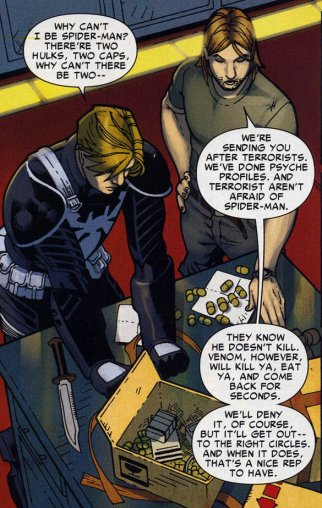
Amazing Spider-Man #654
Dan Slott, Paulo Siqueira, Ronan Cliquet de Oliveira and others

Batgirl #18
Bryan Q. Miller and Dustin Nguyen

This Week in Panels: Week 67
January 2nd, 2011 Posted by GavokHey, folks. First off, check out this awesome interview the 4L monarch David Brothers has done at the Comics Reporter. It’ll take you about three days to read, but it’s a good one.
So while I have the usual suspects in David, Space Jawa (is there any other kind of Jawa?) and Was Taters (is there any other kind of Taters?), I also got one from aggressively horny ducks (are there any… um…). He sent it to David, who found it buried in his spam because it came from a guy named aggressively horny ducks. That’ll happen. Why I obviously have What If #200 taken care of, our foul and fowl reader sent in his own panel because, “I don’t care a lot about continuity but this is just foolish.”
True enough, though if any panel from that issue raises my eyebrow, it’s the one of Namor punching Bullseye while saying — not yelling — “Imperious $#%^.” Imperious what? Imperious cock? Imperious fuck? Did he drop the n-bomb? What?
Sadly, to everyone’s dismay I’m sure, I totally misplaced my copy of Carnage #2. Still, we must carry on.
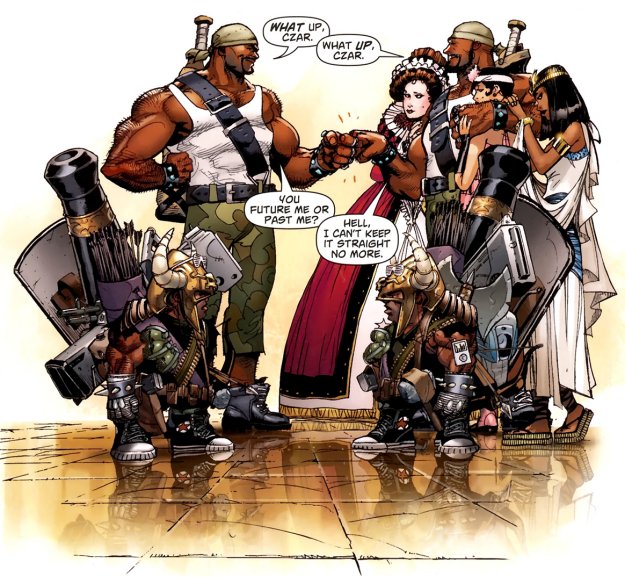
Astonishing Spider-Man & Wolverine #4
Jason Aaron and Adam Kubert
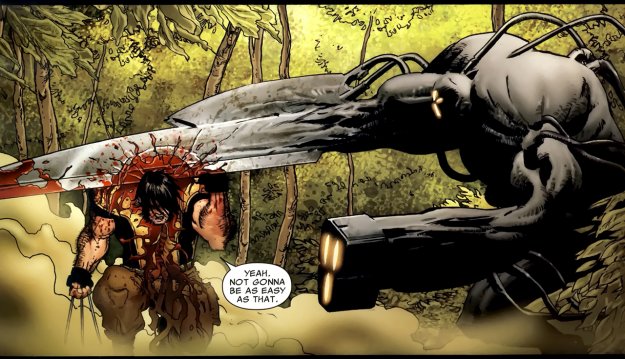
Astonishing X-Men: Xenogenesis #4
Warren Ellis and Kaare Andrews

The Experience [Shadowland: Power Man 02]
September 17th, 2010 Posted by david brothers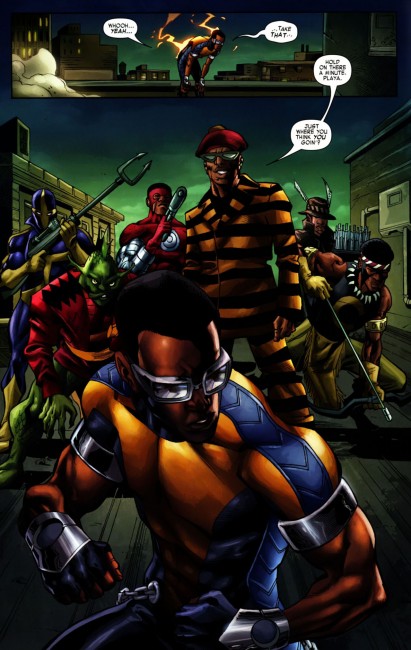
Verisimilitude is what makes stories work. It’s a measure of how true the story is and how closely it sticks to believability. Do characters speak, behave, and dress as they should? It’s a tough thing to nail and even tougher to describe. Verisimilitude requires a lot of intangibles to get right, the sort of things that you can only really judge via gut reactions. One man’s dead-on is another man’s completely wrong.
Creating believable white characters is relatively easy. White’s the default ethnicity for Americans, and we’re positively drowning in white culture, for whatever definition of white culture you choose to subscribe to, so you don’t need a lot of reference. Non-white characters, or white European characters, are something exceptional. They’re black or Mexican or Japanese or Scottish characters, rather than just characters. You have to put some sauce on them to get them right.
The black experience is one of those things that exists, but is different for every single person. It’s just real life–some things are common, other things are rare, and the full experience is something unique. The key to verisimilitude is capturing those common aspects so that people reading it can grab onto them. They provide a touchstone, or something to relate to. The more of the story that is true for you, the more of it that you’re willing to buy into. It’s a con. You get someone to believe one thing and they’re much more likely to believe the next thing you tell them.
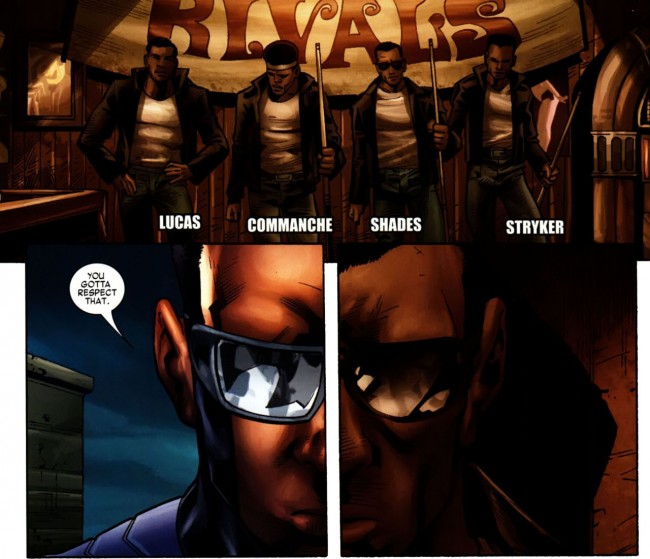
Chris Claremont’s method was to layer on the shtick and hope for the best. It worked well enough at the time, but it comes off corny now. Attempts to make Luke Cage a believable black character resulted in what feels like parody today. If you look closely at your non-white character of choice, you can probably see these tics or traits clear as day. They’re an attempt to lend verisimilitude.

What I liked about Fred Van Lente and Mahmud Asrar’s Shadowland: Power Man 2 is that it’s one of the few cape comics in ages that actually felt like it reflected the black experience. It’s not corny, it’s not ironic, and it’s not self-conscious. It just feels natural. The next closest candidate would be Jeff Parker and Kev Walker’s Thunderbolts, but Power Man surpasses even that. It’s all due to verisimilitude.

It’s the little things. It’s the way Victor’s mom uses his whole name when she gets mad at him. A quick survey of my friends suggests that this happens in black and latino houses, but not so much in white ones. Or the way the white kids talk about how down they are because they listen to black music, clearly one beer and half a blunt away from hitting their black friends with a “my nigga” like it’s all good. It’s how the dialogue has subtle shifts away from the Queen’s English without dropping into a white impression of jivetalk.
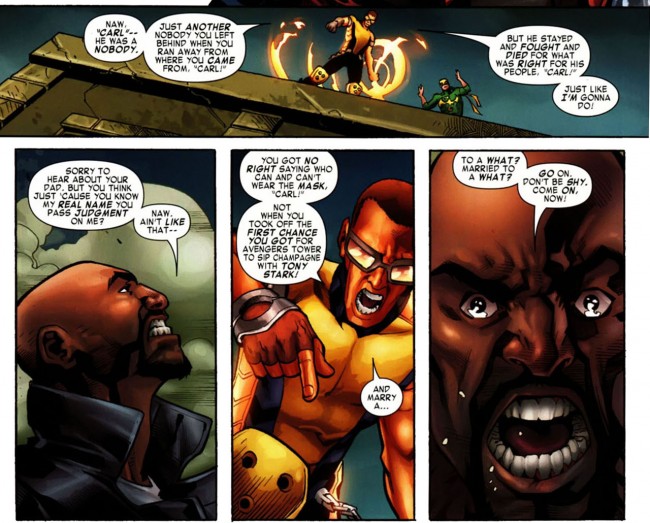
Victor spends the entire issue calling Luke Cage “Carl,” a reference to “Carl Lucas,” his government name. It’s the sort of thing that’s just a diss in and of itself–he’s calling Cage out of his name as a show of disrespect. More than anything else, it puts me in mind of Cam’Ron’s 50 Cent diss “Curtis”, where he turned 50’s real name into a sing-songy diss. It’s both basic disrespect and a reference to the fact that Victor knows who Cage is and doesn’t buy into his hype.
Interracial dating is touchy, too. Every young black male, at least the ones where I’m from, knows to tiptoe around white girls, just in case. There’s nothing that people like better than a chance to paint a black dude as a victimizer of white virginity (see also: Kanye West/Taylor Swift and the out of proportion reaction), and you don’t want to get caught slipping. On the black side of things, a black guy with a white girl is a sell-out. Strong black men (there’s about eight, total) need to stick by their sisters, blah blah blah.
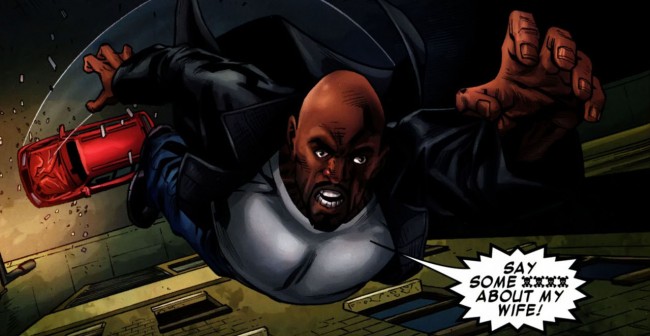
So yeah, when Victor is airing out Cage for leaving the hood and deserting his people, he’s definitely going to get at Cage for marrying a white girl. And yep, Cage is definitely gonna be extremely pissed, because I guarantee almost every black girl he knows (with the exception of Storm) has been giving him the side-eye. That kind of nagging is senseless, but it happens, and people cope. Some people laugh it off. Others get up in your face and dare you to say some ☠☠☠☠ about their wife. Victor’s apology even rings true–it’s an unfair accusation, rooted in centuries old brainwashing, and everyone knows it. But, we still do it.
It is what it is.
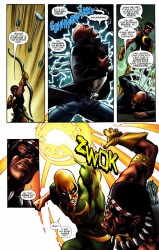 There are other parts that rang true, too. A distrust of altruism and a trust of money. The only people who’ll work for you for free is family, and they’ll only do it under duress. But if you put money in someone’s pocket? That’s a contract. The emphasis on staying where you’re from as an indicator of your realness. Commanche’s implication that getting clean money is less than making brown paper bag money. Most especially, though, is the way that Victor can’t escape his dad’s shadow. He’s going to end up paying for his father’s sins even as he’s busy atoning for something he said to his father by wrapping himself up in his father’s past. He’s stuck in his orbit and he really can’t escape it.
There are other parts that rang true, too. A distrust of altruism and a trust of money. The only people who’ll work for you for free is family, and they’ll only do it under duress. But if you put money in someone’s pocket? That’s a contract. The emphasis on staying where you’re from as an indicator of your realness. Commanche’s implication that getting clean money is less than making brown paper bag money. Most especially, though, is the way that Victor can’t escape his dad’s shadow. He’s going to end up paying for his father’s sins even as he’s busy atoning for something he said to his father by wrapping himself up in his father’s past. He’s stuck in his orbit and he really can’t escape it.
I like that Van Lente is actually using Cage’s past beyond someone talking about how he did time. My main man DW Griffith is still MIA, but Shades & Commanche make an appearance, amongst several other old Cage villains of varying levels of competence. Cage’s past actually has a direct connection to the current story, but not to the point where you have to have read all of his old appearances (though marvel makes it easy on you). I like how it implicitly sets up a road less traveled dichotomy between Cage and Victor’s father. If Cage had chosen differently or stayed with his gang, things could have been very different.
I really enjoyed that Van Lente and Asrar brought back a bunch of Cage’s old villains. They look silly, and they’re treated like jokes, but not like blaxploitation jokes. Ha ha afros and platform shoes! Cage and his comic tend to get summarized as “Where’s my money, honey?” over and over again, which is both a disservice to the character and needlessly reductive. Jokes about how blaxploitation is soooo wacky are trite.
But really, it’s the verisimilitude that did it. I know the FBB4l! axis found it to be a very strong book, and that includes a black guy from the south, a different black guy from New York, a white guy from Kansas, and a Dominican dude from Queens. It isn’t a black book in that it’s constantly screaming at you about how black it is and look at this this is like The Wire, this is the hood, man. No, Power Man builds a world around Victor Alvarez that is just intensely believable. I want more like this.

On Shadowland: Power Man 2
September 15th, 2010 Posted by david brothers
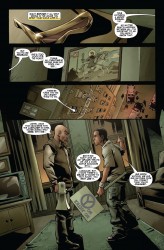
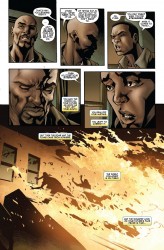
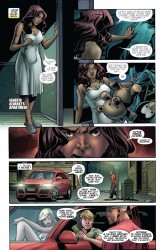
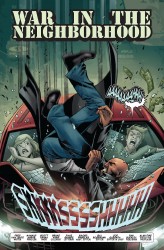
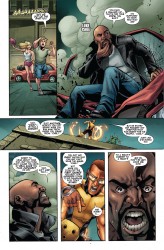
Shadowland: Power Man 2
Words by Fred Van Lente, art by Mahmud Asrar.
I think it’s fair that I speak for both myself and Gavin and say that this is our review of the issue:
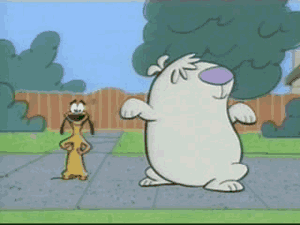
I look forward to this being used as a pull quote for the trade.
(More on this later, as I think that the way this book approaches black life in the Marvel U is super interesting, and ties into something else I’ve been meaning to talk about [Aqualad]. I just wanted to put this out there. Get up on it.)
————–
Edit:
Hey, folks. Gavin here, totally horning in on David’s wonderful post. For those of you who are reading Shadowland: Power Man and you need a retro who’s who, check out my two–parter on Luke Cage’s early villains. Also helps if you read the Luke Cage miniseries from a couple months ago and wondered who the hell Lionfang is.

This Week in Panels: Week 51
September 12th, 2010 Posted by GavokIt’s a nice mix this week from me, David and regular/guest contributor Was Taters. Almost an equal amount of panels all around. Naturally, I had to choose a New Avengers panel with Iron Fist’s flashy new duds on it. Note to Marvel: keep this a thing. Relaunch his book and make that his new status quo costume. Or just relaunch his book.
Taters and I disagreed on which Batgirl panel to go with, but I went with her idea. Can’t believe someone turns down the image of Bela Lugosi riding a segway.
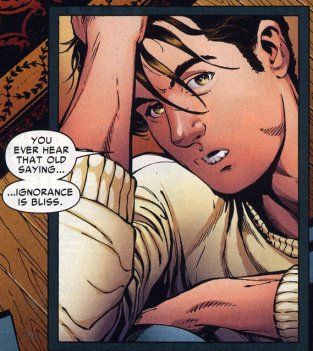
Amazing Spider-Man #641
Joe Quesada, Paolo Rivera, Stan Lee and Marcos Martin
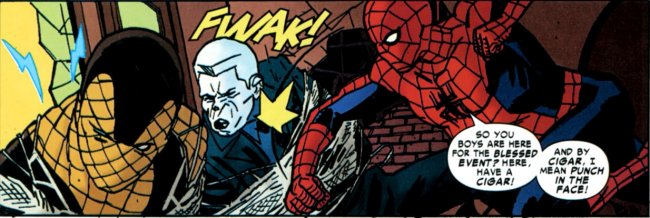
Amazing Spider-Man #642
Mark Waid, Paul Azaceta, Stan Lee and Marcos Martin

7 Artists: David Aja
July 8th, 2010 Posted by david brothers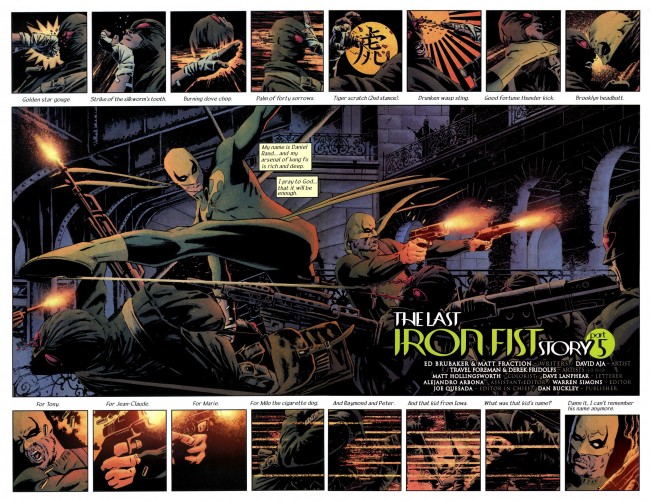
There’s this Grant Morrison quote I like a lot. It’s inflammatory, but I think there’s a lot of truth in it.
As for all this talk I keep hearing about how ‘ordinary people’ can’t handle the weird layouts in comics – well, time for another micro-rant, but that’s like your granddad saying he can’t handle all the scary, fast-moving information on Top of the Pops and there’s really only one answer. Fuck off, granddad. If you’re too stupid to read a comic page, you shouldn’t be trying to read comic books and probably don’t. As creative people, I feel we need to call time on the relentless watering down of comics design and storytelling possibilities in some misguided attempt to appeal to people who WILL NEVER BE INTERESTED in looking at or buying hand-drawn superhero comic books.
The emphasis is mine, and keep it in mind as you read.
How do you read a comics page?
Stupid question, right? But no, not really. The comics page is the most basic building block of a comic book. They haven’t changed too much since they were first invented. You can have words and pictures and you can have ink in CMYK or digital PSDs or AIs in RGB, but without a page to put it on, the tabula rasa of yore, you’re out of luck. It’s probably the one thing in comics that’s genuinely indispensable. (Well, that and ink.)
You could make cases for Jack Kirby, Steranko, and even the often-horrid art of the speculator boom of the ’90s for changing the way people read comics. This change has happened several times. The change came when people began treating the space between the panels, the passage of time that happens there, differently. Panels began to convey different kinds of action.
What’s nice about David Aja’s work is how he treats his layouts. Rather than simply being a tool to convey the story, which is generally how most artists treat their layouts, Aja often turns the layout into part of the story. It’s like if the television you use to watch movies ended up actually introducing new data into your viewing experience.
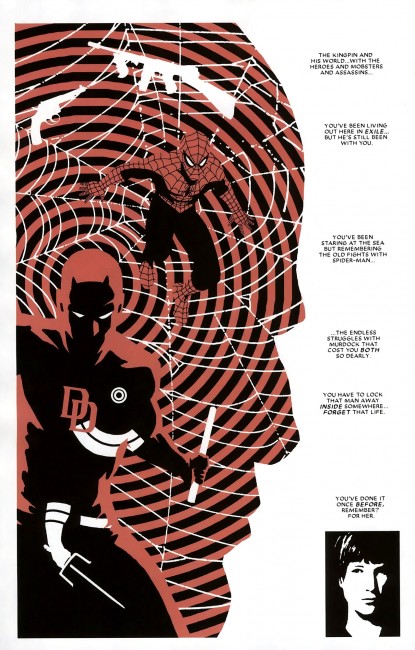
He’s done this in a variety of ways. David Uzumeri wrote a pretty fantastic appreciation of a single page from Daredevil 116 for Funnybook Babylon. It’s absolutely worth reading, if you have the time. The reason why this page is so crucial is simple. (Hopefully I can talk about it without plagiarizing David.) The Kingpin is a man defined by his relationships. The tommy gun and revolver represent his status in a very old-fashioned form of organized crime. Spider-Man was his introduction to the superhero community. Daredevil looms large in Kingpin’s mind, ready for violence, but bottled within Daredevil is a silhouette of Bullseye, Daredevil’s worst enemy and Kingpin’s former chief assassin. Separate from all of that is Vanessa, the Kingpin’s wife. He tried to keep her segregated from his less than savory pursuits, but those pursuits eventually destroyed her.
(When Ditko and Romita would draw Spider-Man with a half-Spidey mask over his face, it was meant to show how Spider-Man and Peter Parker coexisted, and how they cooperated and interfered with each other’s lives. They compete and battle each other, with Spider-Man taking the form of his responsibility and Peter Parker being his inner selfishness. The two halves need each other. They define each other by their existence, and sometimes even their absence. A simple technique–a face that is half Peter Parker and half Spider-Man–with fantastic depth. It’s storytelling quicksand, you don’t realize just how deep it goes til you’re knee deep in it. If that technique went off and had a baby with Steranko’s Agent of SHIELD, and that baby was raised by some of the more out there Frank Miller and David Mazzucchelli stuff on Daredevil, you’d end up with something like this, I think. This is also a technique that only works in comics. It’d look stupid in live action.)
This is a comics page. It’s the same kind of comics page you’ve grown up reading, but it isn’t. The grid is gone, replaced with the outline of a man’s head, and stacked high with meaning. It’s part of the story, not the hanger the story is draped upon.
Next.
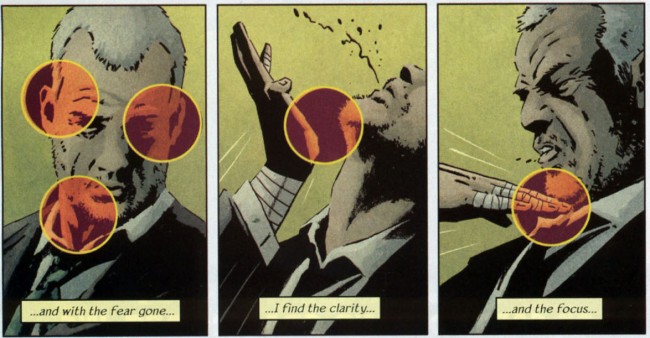
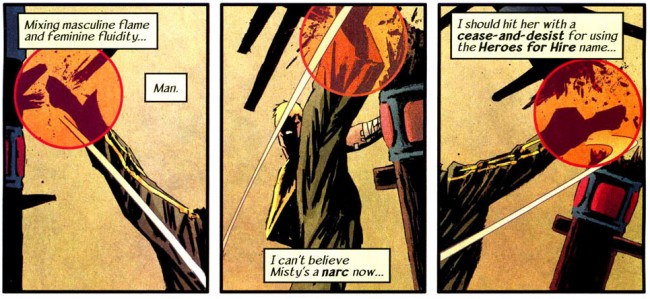
In Immortal Iron Fist, certain punches and strikes get a bit of extra oomph. Aja plays with your sense of time to accomplish this. Each panel on a page is a specific instant in time. When Spider-Man has several afterimages present on a page, doing a diverse array of actions (or just punching one guy 3-10 times), that is meant to take place in the same instant. It’s a show of speed. Aja, though, slams it into reverse and likes to pull your focus in to a specific point on the page you’re reading.
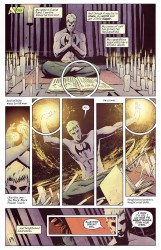
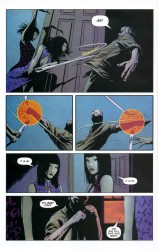
You see the punch in a panel of its own, but there’s a little more added into the mix. Small circles, like targeting reticles in video games, emphasize the point of impact, and by virtue of taking place at one specific moment in time, emphasize the impact itself. It changes the pace of your reading, so instead of going punch-kick-punch-uppercut, you’re seeing punch-jawbone-kick-kidney-punch-neck-uppercut-chin. Four beats become eight, and suddenly you’ve spent more time on the panels, more time focusing on the thing the layout wants you to focus on, than you normally would have. One breath becomes an infinite amount of time, captured like a slideshow.
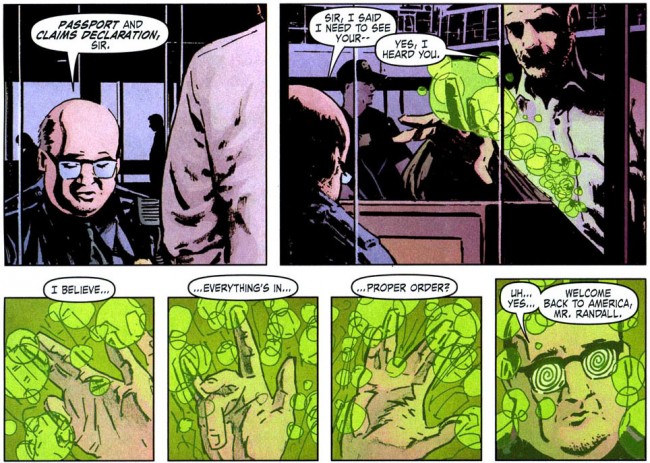
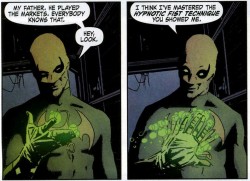 He does something else when Orson Randall arrives in the USA. He does a little jedi mind trick, something that would be a flick of the wrist and a blur of the fingers in real life, and each position of his hand gets a panel dedicated to it. This little bit of nothing, something that later in the book is a mere blur across two panels, gets a lot of page space.
He does something else when Orson Randall arrives in the USA. He does a little jedi mind trick, something that would be a flick of the wrist and a blur of the fingers in real life, and each position of his hand gets a panel dedicated to it. This little bit of nothing, something that later in the book is a mere blur across two panels, gets a lot of page space.
This forces you to dwell on the trick itself, rather than the fact that a trick happened. Imagine if Spider-Man’s web-swinging was drawn differently. Spider-Man in mid-air-right arm curved in-right arm flung out-thwip position-web shooting out-hand pulling tight over the web-right arm pulling back and propelling Spider-Man forward. One action split into seven distinct segments. This is choreography at work.
These are all magic tricks that artists can use to control how you read comics. Aja does it better than most, particularly on Iron Fist. Two things made kung-fu movies exciting: speed and clarity. You want to see people moving quickly and doing impossible things, but you also want to be able to see exactly what Five Elements kung-fu is. If you can’t tell what it is, the action sucks (see also: The Dark Knight). Iron Fist is a kung-fu book, and while the cinematic stylings of kung-fu movies cannot be directly transplanted onto a comics page, Aja does the next best thing. He captures the look and the feel, if not the totality of the motion.
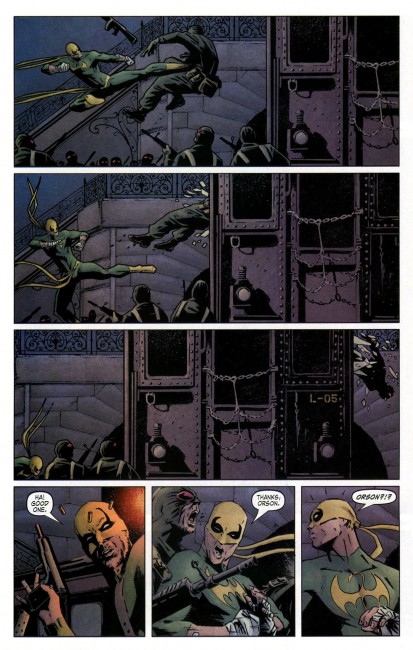
Do you get it?
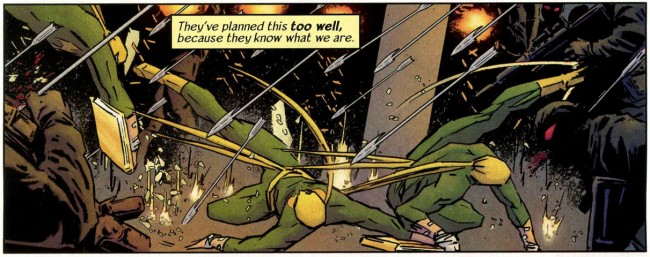
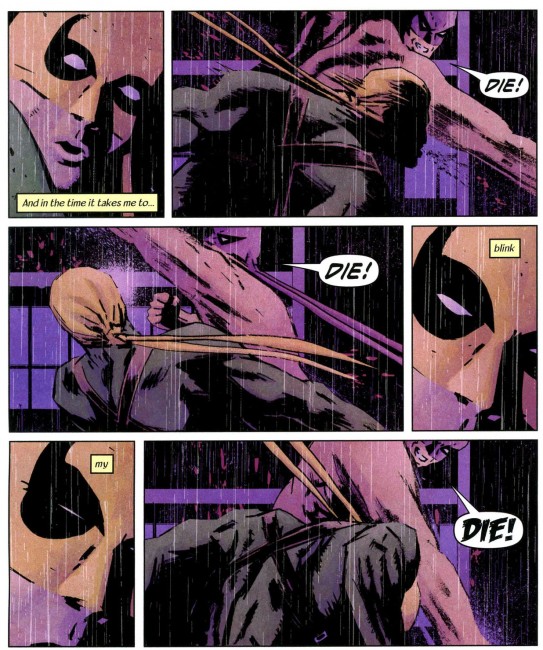
A punch, for a particularly relevant example, is one smooth motion with a lot of moving parts. Your back muscles flex, your arm changes shape, and your body turns with the punch. Throwing repeated punches turns one motion into many, but since they’re taking place on the same body, they have to flow into each other. It’s not as easy as just drawing jab-jab-straight. Look at this Roy Jones Jr highlight reel. Jones is fantastically flashy, but watch how he moves. His legs move, his feet shift, his head bobs, and his body works. Have you ever seen Bruce Lee’s Green Hornet audition video? There’s a lot of similar things on display, and the theory holds true for all of it. Aja applies this sort of thing to comics very well, showing the myriad motions that people go through when they do simple or complex things and picking out the specific moments you need to show maximum action.
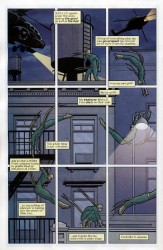
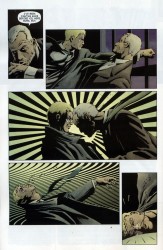
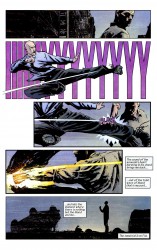
This is the opposite of the watering down that Morrison spoke out against. It’s aggressively pushing forward the standards of what to do with a comics page, how to tell a story, and expanding the language of comics.
And I haven’t even talked about his collaboration with Ann Nocenti, 3 Jacks. Tim O’Neil and Abhay already did that.
Pay attention to David Aja. Pay attention to how you read comic books. Everything matters. It’s all part of the story. And if you can’t handle it… maybe you should quit comics and start reading novels.
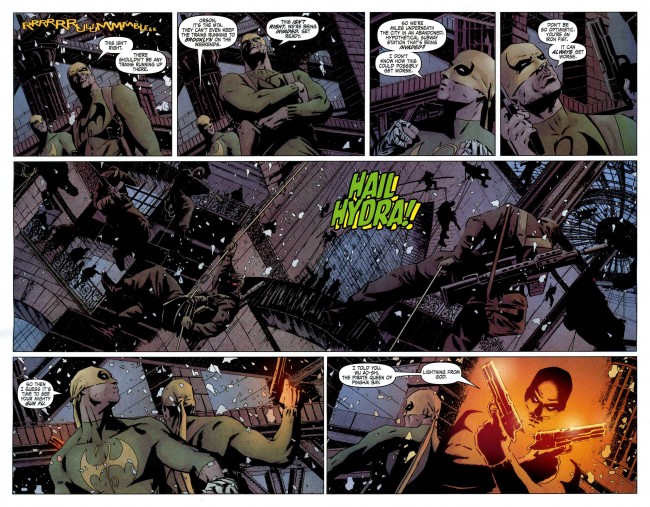

This Week in Panels: Week 10
November 29th, 2009 Posted by GavokA good variety of panels this week. Granted, it may not be the greatest thing that I’ve been reading Clone Saga out of pure nostalgia mixed with curiosity, but that’s still better than hermanos reading Jeph Loeb’s Hulk for whatever damn reason.
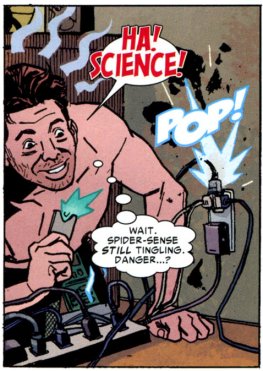
Amazing Spider-Man #613
Mark Waid and Paul Azaceta

Arkham Reborn #2
David Hine and Jeremy Huan
